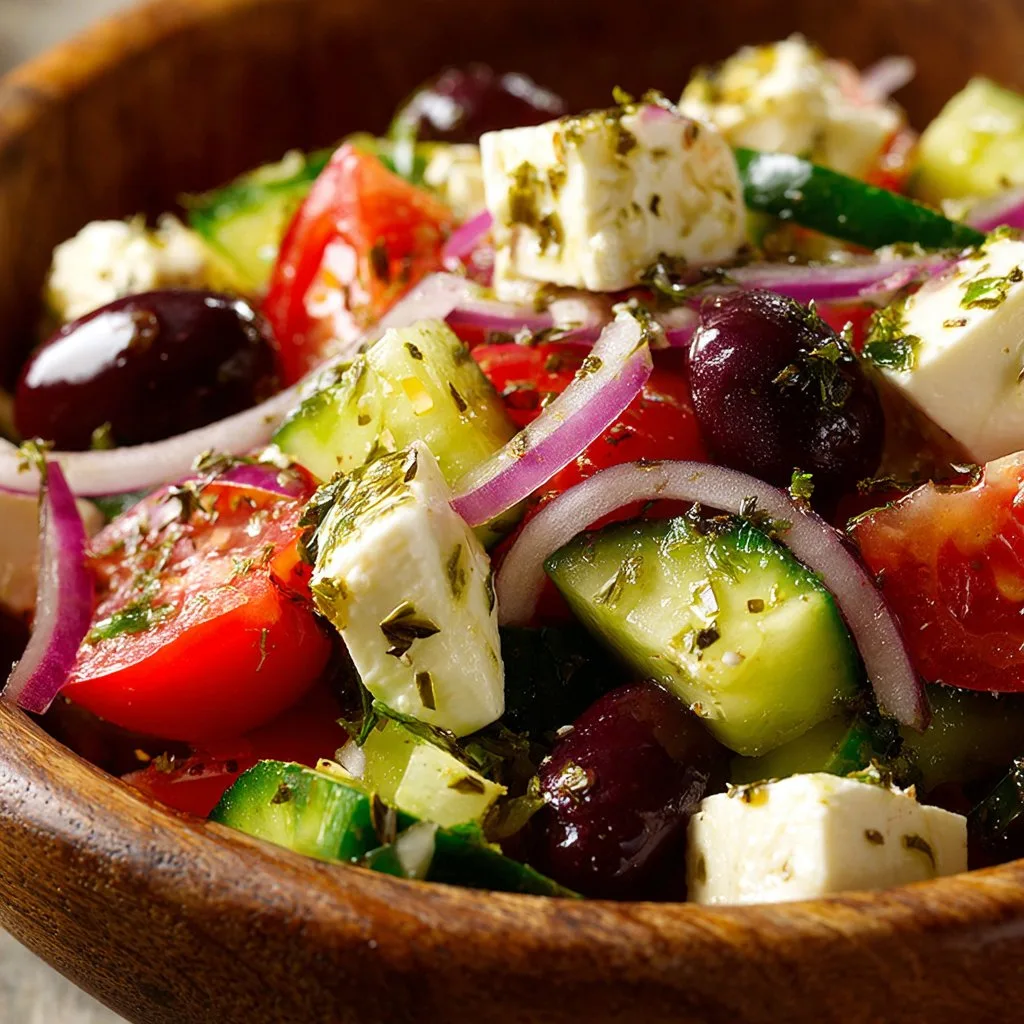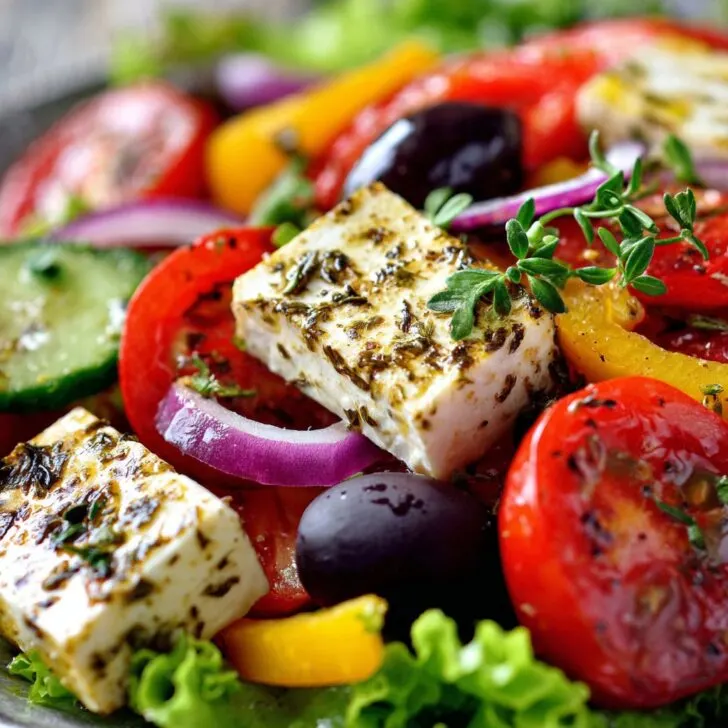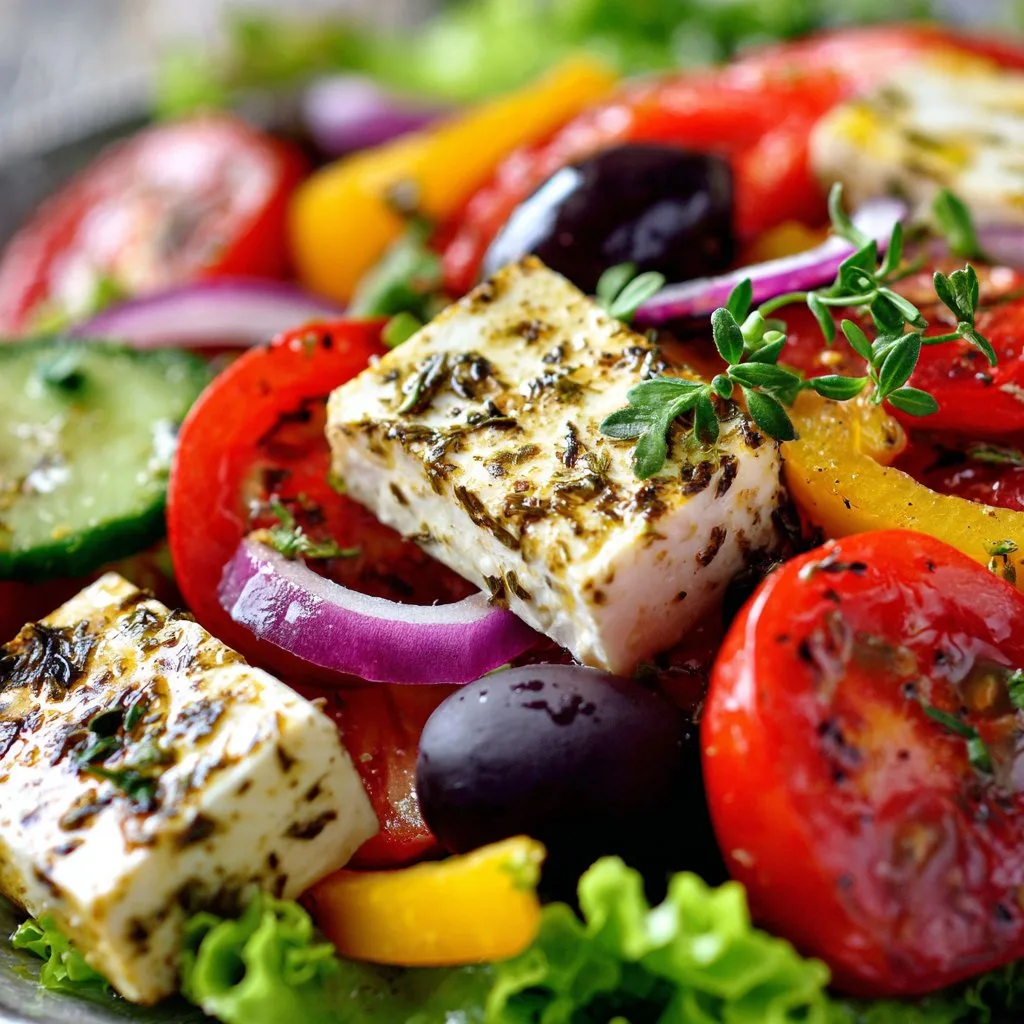So, About This Greek Salad—Let Me Tell You
Alright, so this Greek Salad. I’ve been making it since—well, honestly, I can’t remember if it was a uni flat dinner flop or some summer BBQ where I thought I’d impress people with my “international” cooking skills (spoiler: I once used cheddar instead of feta, and my cousin still brings it up). Anyway, now it’s my trusted backup plan for lazy nights, impromptu lunches, or basically anytime my brain says, “Veggies, please.”
What I love? There’s basically zero cooking, and you get to chop things somewhat haphazardly, which, for me, is weirdly therapeutic. Oh, and if you drop a cucumber slice on the floor, the dog will 100% love you for it. If you’ve never made this classic, I promise—no chef hat needed. Just grab a bowl and a bit of patience for onion slicing.
Why I Keep Coming Back to This Salad
I make Greek Salad whenever I want something that tastes like summer (even if it’s pouring outside, which in Manchester is, like, most of the year). My family goes a bit bananas for it—maybe because they know I’ll let them have extra olives if they set the table. (I’ve even caught my mum picking out the feta cubes straight form the bowl… she’s sneaky, that one.)
Honestly, my only recurring gripe was with the onions—they used to come out too bitey, but I’ve figured out a little trick for that (see the notes below). Anyway, it’s fresh, it’s salty, it’s crunchy, and if I overdo the herbs, no one complains. Okay, except my brother, but he doesn’t count because he thinks pizza is a vegetable.
What You’ll Need (And What I Sometimes Fudge)
- 1 big cucumber (English, or those little Persian ones—if you’re feeling fancy)
- 3-4 ripe tomatoes, chopped (I use whatever’s on offer—cherry tomatoes if I’m feeling posh)
- 1 red onion, sliced thinly (or swap for shallot, especially if you want it milder)
- 1 green bell pepper, sliced (my gran swore by yellow, but honestly, any colour works)
- About a cup of Kalamata olives, pitted (if you forget to pit them, well, you’ll remember next time!)
- 200g feta cheese, cut in cubes or crumbled (I sometimes use those pre-crumbled packs, don’t judge)
- A small handful of fresh oregano (or dried, if that’s all you’ve got—just go easy, it’s potent!)
- For the dressing: 3-4 tablespoon extra virgin olive oil, juice of half a lemon, 1-2 tablespoon red wine vinegar, salt and pepper
Optional: A little sprinkle of capers if you’ve got them. Or not. No pressure.
How I Throw It Together
- Start by slicing your onion up as thin as possible (I’m talking see-through thin, or at least try). Sometimes I soak the slices in cold water for 10 mins to take the edge off. Worth it.
- Chop your cucumber and tomatoes into big, chunky bits—none of those sad supermarket quarter-inch cubes, please.
- Bell pepper? Just slice it into strips. Or weird shapes. It all gets mixed anyway, so don’t obsess.
- Toss it all into a big salad bowl. This is where I usually sneak an olive or three.
- Add the olives and feta on top. You can crumble the feta if you’re feeling rustic, but cubes look nice if you’re trying to impress someone (not that I ever do…)
- Drizzle over the olive oil, squeeze the lemon, splash in the vinegar, and season with salt and pepper. I sometimes chuck in some oregano now, or sprinkle it on at the end. No rules.
- Toss it all gently so you don’t smash the feta too much, unless you’re into that sort of thing. Actually, I find it works better if you let the salad sit for 5-10 mins before eating, so the flavours meld. Up to you.
If it looks a bit random at this stage—relax, it always does. I promise it’ll come together.
My Notes—All the Little Lessons
- If you’re using dried oregano, start with less than you think—it’s stronger than you’d expect. I once got heavy-handed, and let’s just say it tasted like grandma’s spice rack exploded.
- Letting the salad sit gives everything a chance to get chummy. But if you’re really hungry, just dig in.
- I sometimes think the salad tastes even better the next day, but, yeah, it can get a little watery so maybe drain it a bit if you’re storing.
Variations I’ve Tried—Some Hits, Some Misses
- Swapping feta for goat cheese—honestly, pretty good, if you don’t mind going off-script.
- Adding chickpeas for some extra heft—works a treat for lunch. That said, once I tried tossing in grilled chicken… didn’t love it. The flavours just didn’t gel (maybe it was the marinade?).
- I’ve even thrown in roasted red peppers from a jar when I ran out of fresh ones. No complaints!
What You’ll Need Equipment-wise (And My Shortcuts)
All you really need is a chopping board, a decent knife, and a big salad bowl. If you have a mandolin slicer for the onion, great—but if not, just go slow with your knife (and keep those fingers tucked in; I learned that one the hard way).
No salad spinner? Just pat veggies dry with a clean tea towel. Or, you know, let them drip-dry while you have a cuppa.

How I Store It—If There’s Any Left
Stick any leftovers in an airtight container in the fridge. It’s good for a day or two; though honestly, in my house it never lasts more than a day! Sometimes the veggies weep a bit, so you might want to drain off the extra liquid if you’re eating it later.
How I Like to Serve It (And the Weird Traditions)
This salad is basically the Swiss army knife of side dishes. I serve it with grilled fish, or just a big chunk of crusty bread to mop up all the juices. My family likes it picnic-style—outside, on the grass, everyone fighting over the last crumb of feta. You could even try it as a filling for omelettes (I did once, and it was pretty alright).
Pro Tips—Stuff I Learned the Hard Way
- I once rushed the chopping and ended up with weird, uneven bits—tastes fine, but looks a little sad. So, take your time with the knife (unless you genuinely don’t care; fair enough).
- Don’t overdress the salad. Start with less, add more if you need. You can always add, but you can’t take out. Trust me, I’ve tried.
Questions I Actually Get About Greek Salad
- Can I make Greek Salad ahead of time?
Yep, but I’d keep the dressing separate until just before serving if you want it to stay crisp. Sometimes I prep all the veg in the morning and toss it later—works a treat. - Is it okay to skip the olives?
Absolutely. My friend hates them, so I just put a bowl on the side for everyone else. It’s your salad, do what you want! - Do I have to use fresh herbs?
Nah. Dried oregano is totally fine (and actually pretty classic). Fresh just gives it that extra oomph if you’ve got some growing on the windowsill. - Why is my salad watery?
Tomatoes (and sometimes cucumbers) are little water balloons, basically. If that bothers you, just deseed them first, or drain off the extra liquid before serving. Or just grab a spoon and drink it (no judgement, I’ve done it!). - Where do you get good feta?
I usually grab mine from the local market or the cheese shop near the bus station (they have loads of Greek and Turkish cheeses). Supermarket stuff is fine, though—just check it actually says "feta" and not “salad cheese.” Or check this guide on Serious Eats if you want to get nerdy about it.
So there you go. Greek Salad, from the slightly chaotic mind of someone who really just wants dinner to be easy and delicious. Let me know if you try it—unless you’re going to complain about my tomato chopping; then maybe just keep it to yourself. Happy salad-ing!
Ingredients
- 3 medium tomatoes, cut into wedges
- 1 cucumber, sliced
- ½ red onion, thinly sliced
- 1 green bell pepper, sliced
- 100 g feta cheese, cubed
- 16 Kalamata olives, pitted
- 3 tablespoon extra virgin olive oil
- 1 tablespoon red wine vinegar
- ½ teaspoon dried oregano
- Salt and black pepper to taste
Instructions
-
1In a large salad bowl, combine the tomatoes, cucumber, red onion, and green bell pepper.
-
2Add the feta cheese cubes and Kalamata olives to the bowl.
-
3In a small bowl, whisk together the olive oil, red wine vinegar, dried oregano, salt, and black pepper.
-
4Pour the dressing over the salad and toss gently to combine.
-
5Serve immediately, garnished with extra oregano if desired.
Approximate Information for One Serving
Nutrition Disclaimers
Number of total servings shown is approximate. Actual number of servings will depend on your preferred portion sizes.
Nutritional values shown are general guidelines and reflect information for 1 serving using the ingredients listed, not including any optional ingredients. Actual macros may vary slightly depending on specific brands and types of ingredients used.
To determine the weight of one serving, prepare the recipe as instructed. Weigh the finished recipe, then divide the weight of the finished recipe (not including the weight of the container the food is in) by the desired number of servings. Result will be the weight of one serving.
Did you make this recipe?
Please consider Pinning it!!


